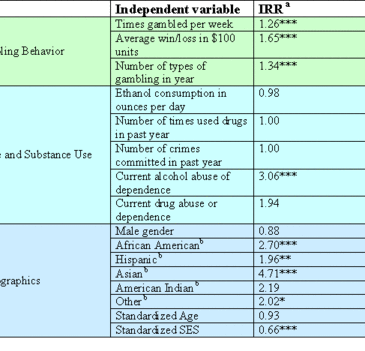Much gambling research has used treatment-seeking populations to study gambling problems and their correlates. Although this research targets late stage efforts to develop treatment for disordered gambling, equally important is research that targets early stage efforts to identify the precursors that make some people more likely than others to develop gambling problems. To better inform prevention efforts, we need information on risk factors for gambling-related problems in the general population. Assuring that interventions are appropriately targeted to high-risk groups can prevent problems from escalating to the point where treatment is needed. This week’s WAGER reviews a recent study (Welte, Barnes, Wieczorek, Tidwell, & Parker, 2004) that identified risk factors in the general population and found that having a lower socioeconomic status (SES) and being a member of a minority sub-population increased the risk for gambling problems.
Welte et al. used randomized phone numbers to contact a nationally-representative sample of U.S. residents 18 years or older. The initial list of 14,700 telephone numbers included 4,036 eligible households. The non-eligible numbers included businesses, non-assigned numbers, and contact with persons mentally or physically unable to participate. Of the eligible households, 2,631 (65.2%) completed the computer assisted telephone interview (CATI). The respondents self-reported their demographic and race information, gambling behavior, alcohol and drug consumption, and recent criminality. Researchers measured pathological gambling, alcohol and drug abuse and dependence with the DSM-IV based Diagnostic interview Schedule (DIS)-IV. The authors ran a regression predicting the number of disordered gambling symptoms from gambling behavior, criminality, substance use, and demographics.
Figure 1. Negative binomial regression predicting count of disordered gambling symptoms, N=2168 (Welte et al., 2004)
a The IRR is the factor by which the dependent variable (PG) is multiplied for one unit increase
in the independent variable.
b Whites are the reference group.
* Significant at p < .05 value.
** Significant at p < .01 value.
*** Significant at p < .001 value.
Figure 1 summarizes the results of the regression analysis predicting gambling pathology with all independent variables entered simultaneously. The number of disordered gambling symptoms is multiplied by the incidence rate ratio (IRR) for each unit increase of the independent variable. For example, an increase of one standard deviation of SES is associated with a 34% decrease in disordered gambling symptoms. For ethnicity, the IRR is the factor by which the dependent variable is multiplied for being a member of an ethnic group, as compared to being White.
Results show that with gambling behavior, alcohol use, drug use, and criminal behavior in the model (i.e., accounting for some of the variance in number of symptoms), being African American, Hispanic, or Asian and having low SES are significant risk factors for pathological gambling. Specifically, being African American is associated with 2.7 times more disordered gambling symptoms, being Hispanic is associated with 1.96 times more symptoms, and being Asian is associated with 4.71 times more symptoms than being white. Having high SES is associated with .66 as many symptoms for every standard deviation increase. Because all variables are entered simultaneously, we can see that minorities have a higher chance of having gambling problems than Whites even when SES is taken into account.
One limitation of this study (albeit specific to the topic of this review) is that the authors might have used oversimplified categories to describe the respondents’ racial background. White and African American Hispanics were labeled Hispanic. The authors might discover a different result if they collapsed their categories differently. Another limitation is the response rate (65.2%). With almost 35% of the randomized national sample missing, these findings might not be representative of the larger population.
Being a minority and having low SES are both associated with a higher number of disordered gambling symptoms. To explain why the minority status was a robust risk-factor for having gambling problems even when SES was in the model, the authors speculate that minorities might have a lower net worth1 than whites (Commerce, 2001), regardless of SES; or, minorities might have different cultural-specific beliefs that value gambling more than whites do. Although the authors included gambling behavior, substance use and criminal behavior in their analysis, an alternate analysis might consider the role of those variables as predictors of disordered gambling symptomatology within different ethnic groups. These independent variables might have different predictive value in models using different ethnic groups. Welte’s study, in addition to raising possibilities for future directions, clearly shows that these sub-populations are at risk for gambling-related problems. By studying these special populations, we can learn more about specific cultural or economic factors that predispose some people to have gambling problems, and the risk factors within these groups that lead to inflated gambling problem rates.
Comments on this article can be addressed to Michael Stanton.
Notes
1 Household net worth is defined as the value of assets, minus debts.
References
U.S. Department of Commerce (2001). Net Worth of Nation’s Households Unchanged. http://www.census.gov/Press-Release/www/2001/cb01-33.html.
Welte, J. W., Barnes, G. M., Wieczorek, W. F., Tidwell, M. C., & Parker, J. C. (2004). Risk factors for pathological gambling. Addictive Behaviors, 29(2), 323-335.





